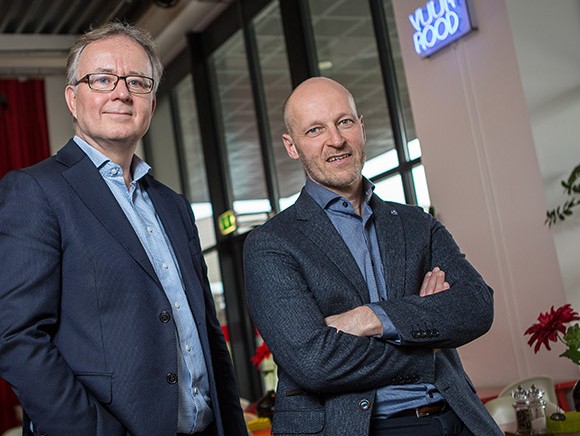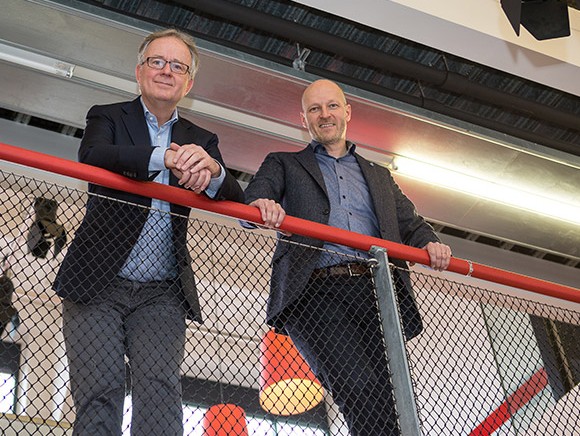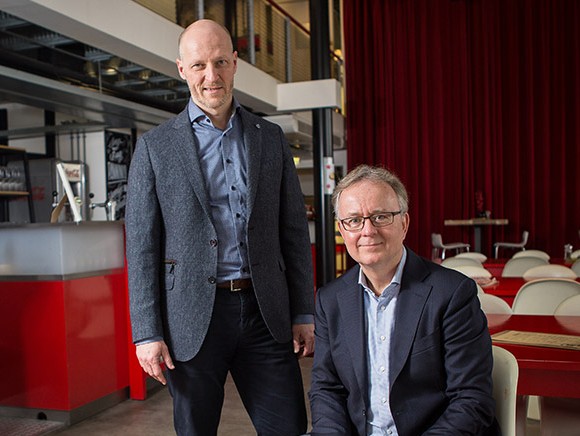
Five years ago, Dick de Koning and Johan Glaser founded PACKZ. The duo regularly attend packaging-related trade fairs and conferences around the world. They enjoy sharing the knowledge they have acquired – by organising their own seminars and by advising, inspiring and mentoring manufacturing companies.
“We’re noticing a huge need for uniqueness and consumer engagement,” says Dick de Koning. “There’s considerable demand for technical possibilities which allow manufacturers to personalise packaging. And new requirements, such as the country of origin labelling law and tracking & tracing legislation, have resulted in innovation; we’re seeing an increase in the in-line integration of packaging and printing. Manufacturers want to be able to alter rapidly changing data per batch. This requirement has produced all kinds of innovations in digital printing, which is achieving ever-faster speeds and better quality. And in-line printing of packaging and films is really taking off; we’re seeing innovations on all fronts: packaging materials and machines, processing and new printing inks.”
“If you want to spot innovations and trends you have to attend the major packaging shows in Tokyo. They really are at the global forefront when it comes to innovative packaging. Japan does much more in terms of recycling and reducing material waste than in Europe. That’s partly for geographical reasons – they are completely dependent on the import of raw materials. This is a driver for all kinds of inventive concepts, such as related to refill. Besides that, they have a strong focus on the country’s biggest target groups: the elderly and the disabled. The country is also focused on visual appeal and they pay a lot of attention to convenience: packaging that really is easy-open and easy-close. Furthermore, they are way ahead of Europe in terms of moulding techniques. I’ve seen mouldable cardboard there that looks fantastic – nicer than plastic, even. When the Japanese develop something new, it always works just like it is supposed to – it’s the finished product. In the Netherlands manufacturers sometimes cut corners on the final details and that annoys me. An ‘easy-open’ pack that still requires a pair of scissors, even though I know that the necessary technology is available to make it possible. It’s all a matter of culture, by the way. The Japanese want everything to be perfect down to one tenth of a millimetre, they won’t settle for anything less. We’re much less concerned about things like that in the Netherlands, and in Europe in general.”
“Our customers are active on a worldwide level. The things we do and the advice we give depends on many different factors – on the product and what the customer wants, but also on factors such as geographical location, the sales market and the local culture. We work at the crossroads where ideas become reality and we contribute to finding the right technology, drawing on our knowledge about things like how the packaging materials interact with the product, supply chain, marketing and legislation; a lot of hard work goes into designing and taking a new packaging concept to market.”
“All sectors have to become more sustainable, there’s no doubt about that. In Nederland Circulair the Dutch government also writes that it is ‘striving, in conjunction with relevant stakeholders, towards an economy in which we only use sustainably produced, renewable or generally available raw materials and leave as little waste as possible behind’. In my view, however, there incentive for the private sector is too small. The description of the objectives to be achieved lacks imperative. It’s also a typically Dutch approach to simply ‘all make an attempt’ rather than imposing compulsory measures. Thankfully there’s also a lot happening – the trend is catching on. We’re involved in numerous projects that are looking at a combination of design and recyclable materials. I’ve seen plenty of good initiatives, such as Bar-Le-Duc’s 100% rPET bottle and Peeze’s compostable coffee cups.”
“Above all, brand owners want the packaging to reflect their brand image. The product must be eye-catching on the shelf, so the packaging has to stand out in terms of the printing, shape and choice of materials. Packaging also has to meet a huge number of requirements, especially for fresh food. Everyone wants packaging that adds value, and they are also continuously looking to reduce costs. Food safety and shelf life play an even bigger role than sustainability. That’s why mono-material packaging isn’t feasible for many products. Nowadays, when choosing packaging materials, one important question is whether the material is bio-based and/or recyclable. The Netherlands Institute for Sustainable Packaging (KIDV) has recently devised four new plans for improving the sustainability of the industry. In the highest achievable goals in those plans, the emphasis is on reducing unnecessary packaging and/or packaging material and on improving the recyclability and recycling of packaging. Many sectors have also formulated highest achievable goals in terms of the reuse of packaging and the use of renewable raw materials.”

“In this area, too, the changes are being strongly influenced by a number of societal drivers. Intelligent packaging could be the solution to a variety of issues – think of consumer questions such as ‘How do I know whether the product that I want to buy or use really is still fresh?’ or ‘How do I know whether the product that I’m about to buy really is what I think it is?’. Some food is still tampered with and all kinds of fake products make it onto the market. In the meantime, manufacturers are struggling with the relationship between the costs and the benefits; the Netherlands has a very cost-conscious culture which can sometimes hold back innovation. But there are success stories in premium categories, such as spirits where Johnny Walker Blue Label and Remy Martin are good examples.”

“I expect this trend to continue and packaging to become ever-more intelligent and to include advanced technology – such as RFID chips – increasingly often. RFID, which stands for radio frequency identification, is a way of identifying objects using radio signals. RFID tags are tiny chips containing an identification code that can be read remotely. You could see RFID as an advanced successor to the barcode. It can store more information, the chip can be concealed in items virtually invisibly and it can be scanned using a smartphone. However, it is still relatively expensive and therein lies the bottleneck: striking the right balance between costs and added value. Plus, equally importantly, consumers have to understand how it works.”
Source: ©Peter Roek